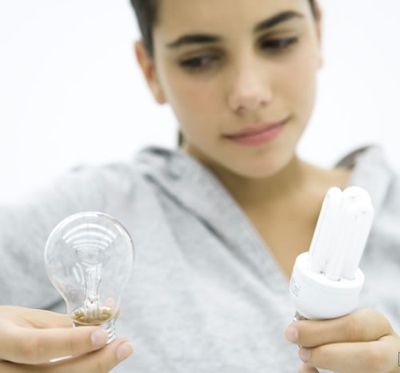Recycling Compact Fluorescent Light Bulbs Is a Bright Idea

Are you trying to find ways to green your home and save some money on your energy bills? You can do both by replacing incandescent light bulbs with Compact Fluorescent Light (CFL) bulbs.
CFLs and other fluorescent light bulbs are an extremely energy-efficient lighting option, as they require less energy than incandescent light bulbs to provide the same amount of light. They also last up to 10 times longer than incandescent light bulbs, making them a cost-effective alternative to incandescent lighting.
By using fluorescent lights and reducing home energy use, Americans can reduce the amount of coal burned for energy, a major source of mercury releases. A coal-fired power plant emits 13.6 milligrams of mercury to produce the electricity required to power an incandescent light bulb, compared to just 3.3 milligrams for a CFL. Thus, using CFLs reduces the amount of mercury emitted into the environment.
However, because CFLs contain an average of 4 milligrams of mercury, they need to be recycled. Fluorescent light bulbs that are discarded in the trash, disposed of in landfills, or incinerated will break and release mercury into the environment. Therefore, the U.S. Environmental Protection Agency strongly encourages the recycling of all mercury-containing light bulbs.
Some states require households to recycle their mercury-containing light bulbs after they burn out. Household hazardous waste collection programs often accept these light bulbs. For information about state-specific requirements, please contact your state or local environmental regulatory agency. If your state or local environmental regulatory agency offers no recycling options, and allows disposal of CFLs in household garbage, place the burned-out fluorescent light bulb inside two sealed plastic bags. Place the sealed bags inside a trash can or other protected outdoor location to await the next scheduled trash collection.
For those seeking mercury-free, energy-efficient alternatives to mercury-containing light bulbs, lighting products that use light-emitting diodes (LEDs) fit the bill. LEDs are currently used in applications ranging from traffic signals and exit signs to Christmas tree ornaments and the Times Square New Year’s Eve Ball. While LEDs are currently more suited to task-specific lighting such as desk lamps, reading lights, and nightlights, several manufacturers are working to develop LEDs for general lighting uses.
As with many other household items, such as paint and certain cleaners, we need to pay attention to how we dispose of CFLs. With proper care, fluorescent bulbs can benefit the environment through reduced energy consumption and save you money.
To learn more about CFLs and other fluorescent light bulbs, their energy efficiency, and proper disposal, please visit www.epa.gov/bulbrecycling.
Find out what household hazardous waste collection and recycling programs are available in your area by visiting www.epa.gov or www.earth911.org.